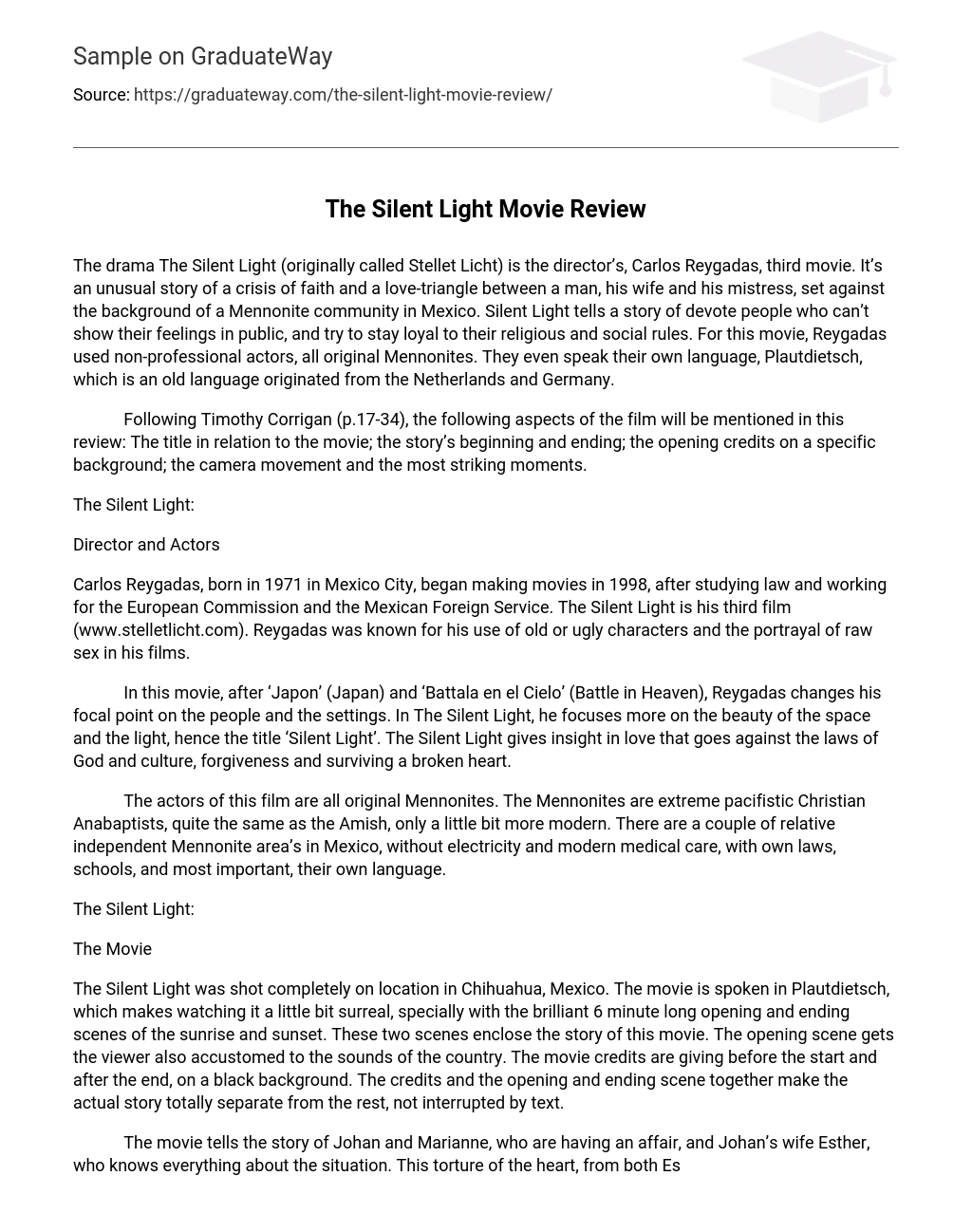The drama The Silent Light (originally called Stellet Licht) is the director’s, Carlos Reygadas, third movie. It’s an unusual story of a crisis of faith and a love-triangle between a man, his wife and his mistress, set against the background of a Mennonite community in Mexico. Silent Light tells a story of devote people who can’t show their feelings in public, and try to stay loyal to their religious and social rules. For this movie, Reygadas used non-professional actors, all original Mennonites. They even speak their own language, Plautdietsch, which is an old language originated from the Netherlands and Germany.
Following Timothy Corrigan (p.17-34), the following aspects of the film will be mentioned in this review: The title in relation to the movie; the story’s beginning and ending; the opening credits on a specific background; the camera movement and the most striking moments.
The Silent Light:
Director and Actors
Carlos Reygadas, born in 1971 in Mexico City, began making movies in 1998, after studying law and working for the European Commission and the Mexican Foreign Service. The Silent Light is his third film (www.stelletlicht.com). Reygadas was known for his use of old or ugly characters and the portrayal of raw sex in his films.
In this movie, after ‘Japon’ (Japan) and ‘Battala en el Cielo’ (Battle in Heaven), Reygadas changes his focal point on the people and the settings. In The Silent Light, he focuses more on the beauty of the space and the light, hence the title ‘Silent Light’. The Silent Light gives insight in love that goes against the laws of God and culture, forgiveness and surviving a broken heart.
The actors of this film are all original Mennonites. The Mennonites are extreme pacifistic Christian Anabaptists, quite the same as the Amish, only a little bit more modern. There are a couple of relative independent Mennonite area’s in Mexico, without electricity and modern medical care, with own laws, schools, and most important, their own language.
The Silent Light:
The Movie
The Silent Light was shot completely on location in Chihuahua, Mexico. The movie is spoken in Plautdietsch, which makes watching it a little bit surreal, specially with the brilliant 6 minute long opening and ending scenes of the sunrise and sunset. These two scenes enclose the story of this movie. The opening scene gets the viewer also accustomed to the sounds of the country. The movie credits are giving before the start and after the end, on a black background. The credits and the opening and ending scene together make the actual story totally separate from the rest, not interrupted by text.
The movie tells the story of Johan and Marianne, who are having an affair, and Johan’s wife Esther, who knows everything about the situation. This torture of the heart, from both Ester and Johan, is the red line of the movie. Also the grief of Marianne becomes part of this love-sorrow. The three of them live in a small, very religious community, where it is hard to hide your emotions. Although everybody apparently knows about the affair, it is not openly discussed.
It is a movie based on ambiance, environment and characters, what makes the movie sometimes very slow and hard to comprehend. The minute long scenes of the surroundings, the slow moving camera and the silence of the characters are perfectly choreographed. Even the focus of the camera hardly changes. This makes some scenes extra real, especially the scene where Johan and Marianne decide to stop their romance.
Because Reygadas uses non-professional actors, now and again, the movie seems to look more like a documentary. The overall mood, the hidden sadness and the focus on surroundings become more apparent without the use of music. The only sound you hear is the sound of the chirping crickets, the waving corn, the riding cars, the radio and the crunching snow.
The real goal of the movie stays somewhat unclear. It seems to be a story about the acceptance of faith and the acceptance of God’s will. Therefore the idea behind the rather strange ending is quite vague. The movie stays silent about this, what might bring irritation. Reygadas does not answer the questions which arise during watching the film. He leaves everything open and implies a mystical resolution. But what that resolution is, does not become known to the viewer.
Works Cited
Corrigan, T. 2004. A short guide to writing about film. 5th ed. New York: Longman.





